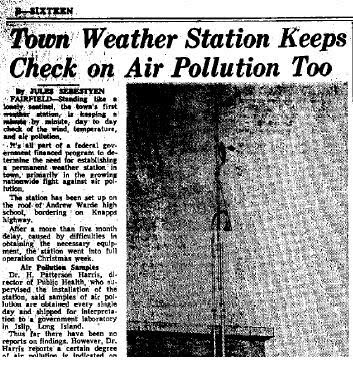.png) Fairfield's first weather station, which kept a minute-by-minute, day-by-day check of the temperature, wind, and air pollution, was set up on the roof of Andrew Warde High School 46 years ago this month.
Fairfield's first weather station, which kept a minute-by-minute, day-by-day check of the temperature, wind, and air pollution, was set up on the roof of Andrew Warde High School 46 years ago this month.The station was the product of a federal government-financed program to determine the need for establishing a permanent weather station in town, primarily due to the nationwide fight against air pollution.
After a more than five-month delay caused by difficulties in obtaining the necessary equipment, the station went into full operation in January of 1966.
Dr. H. Patterson Harris, the director of public health who supervised the installation of the station, said samples of air pollution were obtained every day and shipped for interpretation to a government laboratory in Islip, New York. Dr. Harris reported a certain degree of air pollution was indicated on smoke shade samplers, which were a part of the survey.
Plans were being made to file another application for a federal grant to continue the weather station beyond the first week of June in 1966.
 Andrew Warde High School was chosen as the site of the weather station because it is located at one of the highest elevations in Fairfield, it is on town property, and high school students studying meteorology would have the opportunity to learn about climate and current weather conditions from the station's data.
Andrew Warde High School was chosen as the site of the weather station because it is located at one of the highest elevations in Fairfield, it is on town property, and high school students studying meteorology would have the opportunity to learn about climate and current weather conditions from the station's data.Several other sites, including Fairfield Woods Junior High School, were also considered, but because of the advantages to the high school students, Warde was ultimately selected over Fairfield Woods.
The station was serviced each day by Thomas Haydon, the newest member of the health department staff, who changed the 24 tubes which collected air samples and recorded daily minimum and maximum temperatures, wind direction, and velocity. The tape for the smoke shade sampler was changed once a week. The tubes containing the air samples had to be shipped each day to Islip.
The Warde weather station formed a geographical triangle with the Greater Bridgeport weather station, located at Sikorsky Memorial Airport, and the Stratford station, located atop Bunnell High School. Both the Warde and Bunnell weather stations were equal distances from the airport, a significant factor in the study of air movement.
The heart of the weather station was the mast outside the building. The weather vane, atop the mast, through electrical power, transmitted wind direction, and the spinning anemometer balls, just below the weather vane, transmitted wind velocity to a recorder sheltered in a cabinet indoors. Wind direction was recorded every five minutes, while wind velocity was recorded continuously.
Below the anemometer balls was a curved pipe containing two tubes to funnel air to equipment inside the building. One tube sucked the air onto a tape recorder-type instrument equipped with a filter paper for the purpose of measuring the density of the air pollution.
Instruments to record the temperature were housed outdoors in a mounted box with slat openings on all four sides. Arms on the instrument stopped automatically at the low and high points for the day.
Dr. Harris said the initial year grant totaled $15,100, of which about 70 percent went for equipment. The remainder was for consultant's fees and education.
Paul

No comments:
Post a Comment